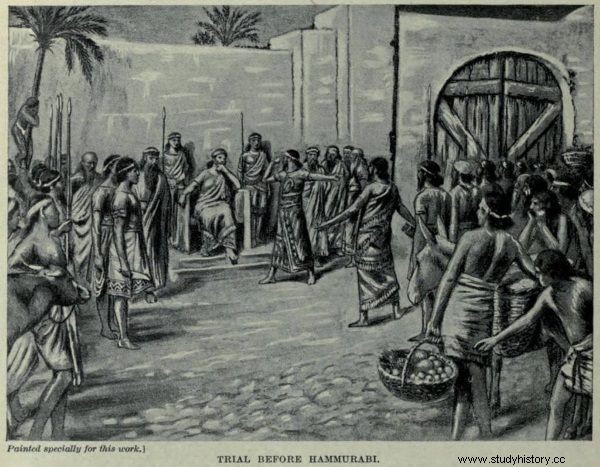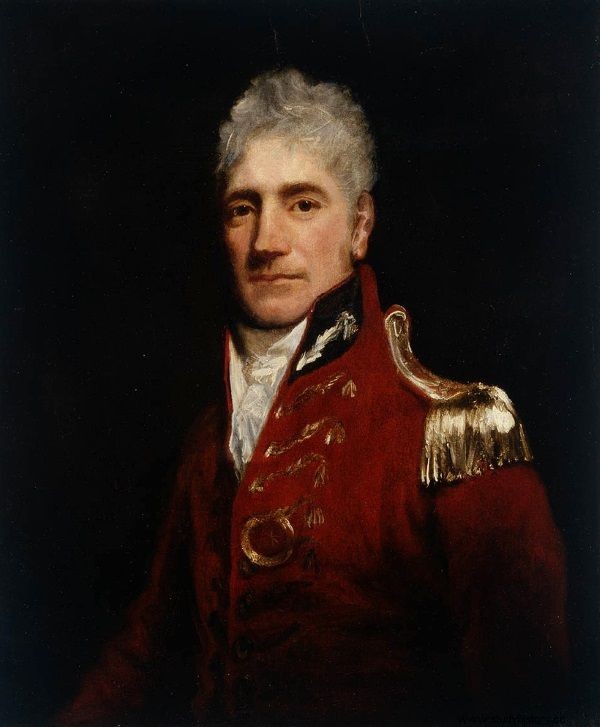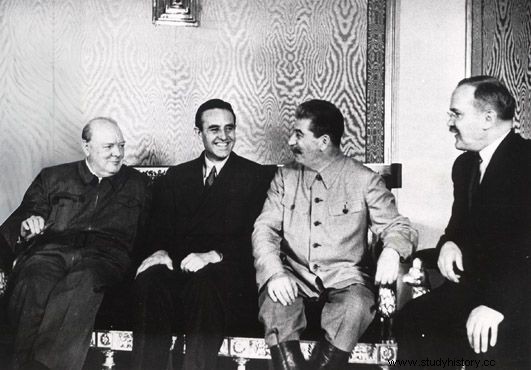The death penalty for every woman who drank wine, the bizarrely organized prohibition of the Aztecs, the party habits of Joseph Stalin and the secrets of organizing pubs in the Middle Ages. What else did you not know about drinking and drunkenness?
1. In ancient Mesopotamia, only women were brewing and running taverns
The Code of Hammurabi, the famous body of laws drafted in the 18th century B.C.E., regulated various aspects of the life of the Babylonians. There is a very interesting section in it devoted to the issue of beer and the duties of innkeepers. As established several dozen centuries ago:
108. If the innkeeper did not accept grain as payment for the beer, but took too much silver according to the weight, or the equivalent of the beer in relation to the value of the grain was lowered and it will be proved to the innkeeper to water, throw it in.
110. If the priestess or high priestess who does not live in the monastery opened the tavern, or for beer in the tavern, the citizen will be burned.
111. If the innkeeper has given one bowl of beer (60 liters) on credit, she will take 50 measures of grain during the harvest.

The trial before Hammurabi (Patrick Gray, license CC BY 2.0)
Mainly men attended the Sumerian taverns, while the business was conducted by women, who also brewed beer, although under the supervision of brewers. As Mark Forsyth emphasizes in his book "A Brief History of Drunkenness" taverns were very shady premises. These are dark, little bars right on the street where people could meet, plot, do cloudy business and complain about the rulers.
2. The Aztecs were "drunk as four hundred rabbits"
The Aztec pantheon, although wildly colorful, is not, unlike the Greek one, known to the masses. Among the gods worshiped in Mesoamerica are Mayahuel of 400 breasts, the goddess of agave, which is used in this part of the world to make soft drinks, and Patecatl, the god of fermentation.

Goddess Mayahuel (Photo:Public Domain)
The combination of these two powerful beings gave, in the light of Aztec beliefs, an interesting result. From the union that is formed by alcohol in nature, 400 divine bunnies, Centzon Totochtin, were born. It was a group of lesser deities, personifying individual states of intoxication. One of the Indian proverbs says that everyone has their own rabbit, that is, their own mood when consumed.
3. The holiday of one of the Egyptian goddesses was about great drunkenness and casual sex
According to Egyptian legend, the god Re asked Hathor to wipe out wayward humanity. The goddess took the task to heart and began methodically murdering. Re finally changed his mind about getting rid of the bipedal problem, but Hathor didn't want to break the hecatomb.
So God took seven thousand barrels of beer, which he colored red, and poured it over the fields. Hathor, thinking it was human blood, started to drink them and got so shaken that she fell asleep, breaking her murderous frenzy. Celebration in honor of the goddess consisted of drinking to the point of vomiting, and indulging in lust in the temple corridor.
Successive spells with wine were emptied until the holy state of complete intoxication and, with the priest's encouragement, indulged in erotic rapture (as Forsyth emphasizes in the pages of A Brief History of Drunkenness , in different configurations, everyone with everyone). Interestingly, coming into the world 9 months after Hathor made you proud and opened the way to the priesthood.
4. In ancient Rome, women were not allowed to drink wine
In ancient Rome, social norms relegated women to the role of beings subordinate to men, which resulted in many restrictions being imposed on them. One of them was the ban on drinking wine. Supposedly, according to the law already established by Romulus, any woman who would break the sanction was subject to the death penalty. In practice, the husband determined the amount of penance for such a criminal. Sometimes he did not regret his strength. As we can read in the first century C.E. in the book "Deeds of Memories":

Bacchus - Roman god of wine, painting by Caravaggio (photo:public domain)
Egnatius Metellus beat his wife with a club because she had drunk some wine. Not only did no one accuse him of the crime, no one even blamed him. Everyone agreed that he was a perfect example of how to punish sobriety violations.
5. The medieval pub was recognizable by the stick
Before real signboards appeared and spread, traveled travelers had to be able to somehow recognize a place where they could moisten their throats. Beer was not always sought in taverns and pubs. The drink at that time differed significantly from what we know. It contained alcohol and was nutritious, but more like watered-down oatmeal that could only be eaten for a very short time.
Therefore, it was often brewed, also in private homes, and then sold. When the beer was produced by an ordinary hostess, she somehow had to let people know that it was possible to drink at her place. She did it by placing a so-called beer stick above the lintel, i.e. a stick to which she attached any pan at the end. Alternatively, she could also put a barrel with alcohol and a bench in front of the house.
6. The Australian health care system was born out of fraud and drunkenness
Australia for a long time was a penal colony where convicts were sent to work forcibly for the good of the British Empire. Sydney's shed was used for all of Sydney's medical infrastructure. In 1809, a soldier, alcoholic and perfect con artist was appointed governor of the colony, whose last name was Lachlan Macquarie. The new governor made it a point of honor to build a hospital and decided to use his control over the alcohol trade to do so.

The figure shows a beer stick (photo:public domain)
He promised wealthy settlers a rum monopoly in exchange for building a hospital. Besides, only government officials could sell alcohol they already owned. The settlers agreed and saw a golden deal in it, not realizing that Lachlan Macquarie had warehouses full of liquors. In the end, the governor made money selling his rum and taxed the profits of the settlers. Australia also received its first hospital, which had two main pillars - no toilets, and ... a morgue.
7. The ancient Chinese used to go to funerals to get drunk
To deal with possible drunkenness, the ancient Chinese made alcohol consumption a whole host of regulations. Free drinking was frowned upon unless it was part of a ceremony or ritual. Funerals were, for example, one of these occasions. As Mark Forsyth writes :
There have been complaints about people going from funeral to funeral consuming as much alcohol as they could fit in their stomach, presumably shedding one tear politely for the dead.

The clever Governor Lachlan Macquarie.
8. Most of the salons in the Wild West were nothing like the elegant bars we know from Westerns
In the first half of the nineteenth century, Americans set off to the Wild West to earn by building railways, mining towns popping up like mushrooms after the rain, or from the fur boom. The virgin lands where they sought happiness did not have the necessary infrastructure. When the settler, tired of a hard day's work, wanted to moisten his mouth in a glass of something stronger (due to the distance and transport costs, strong whiskey was drunk rather than beer), he directed his steps to the living room. For this purpose, he did not go through the massive swinging door, with the setting sun behind his back, but rather went ... to the tent, where he would sit on the simplest bench and receive a glass. As we can read in the book "A Brief History of Drunkenness" :
Anyone interested in making money could hear about the new mining town […]. So he took a barrel under one arm, a tent under the other, and then showed up in a new place. This is how the saloon was created. Sometimes it was a board on two barrels, a bar like that. [...] Often the tent bartender (if he can be honored with this title) would just sell all the stuff and go home.
9. Stalin kept his politburo in check because of his drunkenness
Joseph Stalin ruled the Soviet Union brutally, holding firmly to everyone, including his closest associates. The dictator very often made irrefutable offers to his subordinates - they were to appear in the Kremlin the same day and take part in a dinner to which the entire politburo was invited. Dinner, however, is too soft a description of what happened at these meetings.

For Churchill, the diplomatic visit to Moscow in 1942 ended with a giant hangover. In the photo, from the left, Churchill, William Averell Harriman - the American ambassador to the USSR - Stalin and Molotov.
Stalin, who himself consumed small amounts of alcohol, drank his guests excessively and only let them out when they were completely flooded, and it was dawn outside the window. The scale of drunkenness was enormous - there were parties during which more than twenty toasts were made before the first course with pure vodka! Politicians, after many hours of drinking and taking care not to offend the leader with the rest of their strength, refrained from falling asleep at Josif Wissarionowicz's table. It would be suicide. Khrushchev complained about these dinners. Stalin was able to empty the pipe on his bald head during the drunkenness of this politician.
10. Drinking was forbidden among the Aztecs, unless you were old
The Aztecs drank pulque, the fermented agave juice. Some considered him to be the source of all evil, and the rulers issued orders forbidding alcohol consumption under penalty of death. For example, she threatened a priest who would take an alcoholic drink or a clerk. An ordinary mortal could count on a lenient punishment, which in this context was considered a public shaving of the head and ... the demolition of the house belonging to the delinquent.
Only old people who already had grandchildren could drink without any consequences, apart from a hangover. Interestingly, one of the elements of the Aztec naming ceremony was that old men of both genders gathered to collectively get drunk on pulque, and the person responsible for the pouring gave them more batches until it felt they were all equally flooded.
